1. Summary
This Guideline is for fractures of the phalanges of the ulnar four digits (index, middle, ring and little fingers).
Fractures of the THUMB are covered separately, as are METACARPAL FRACTURES.
Finger injuries are a very common reason for children to present to an Emergency Department. In young children this is most often from crush injuries in the home, whilst older children are more likely to be injured in sports.
A variety of skeletal or ligamentous injuries can occur, with some subtle variations in the early care required for each. Early appropriate care can save significant later impairment in everyday function.
2. How are they classified?
Can be classified as
- Open/Closed,
- Displaced/Nondisplaced
- By presence and type of growth plate involvement (Salter-Harris classification)
- By anatomical location of which phalanx is affected
- … and by co-existing tendon or nailbed injuries
Specific injury types are listed in the table under point 6.
3. How common are they and how do they occur?
Finger injuries including fractures are a common reason for children to present to an Emergency Department.
Injuries among toddlers and younger children are commonly from a crushing mechanism associated with exploring their environment.
Injuries among older children more often result from falls or sporting injuries, and are more often displaced or angulated than in younger children.
4. What do they look like – clinically?
Fractures of the finger usually present with localised swelling, bruising, tenderness, with or without deformity. Significant angulation or displacement of fingers is sometimes mistaken for dislocation clinically.
There may be ‘scissoring’ of the fingers if there is a rotational deformity present.
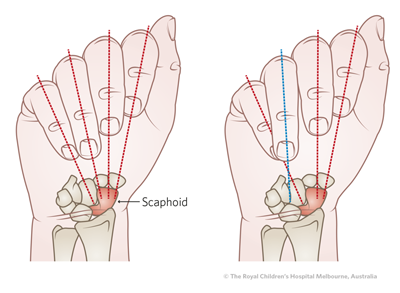
Rotational deformity of the ring finger
Subtle fractures may be difficult to detect clinically so the clinician should have a low threshold for arranging Xray in the presence of pain and loss of function
Findings in specific fractures are listed in the table under point 6 below.
5. What radiological investigations should be ordered?
AP and lateral, and oblique Xray of the affected hand
Communication to the radiographer regarding in which finger is injured allows the film to be centred over the area of interest.
6. What do they look like on X-Ray?
Distal Phalanx Fractures
|
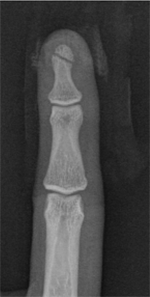
|
Tuft Fracture (crush injury)
Soft tissue injury is often more obvious; Xray required to detect underlying fracture
Management consists mainly of treating any associated soft tissue or nailbed injury or tip avulsion. Place in a neutral hand splint (see point 9) and start oral antibiotics for any open fractures.
Follow up is with GP for most injuries, but Hand Surgery team if nailbed repair required.
|
|
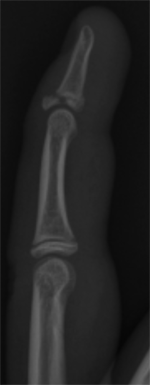
|
Mallet Injury
Forced flexion of extended finger, with extensor tendon avulsion fracture at insertion site
On examination distal phalanx is in flexed position with no active extension of DIP joint (“extensor lag”).
Tenderness over dorsal aspect of DIP joint.
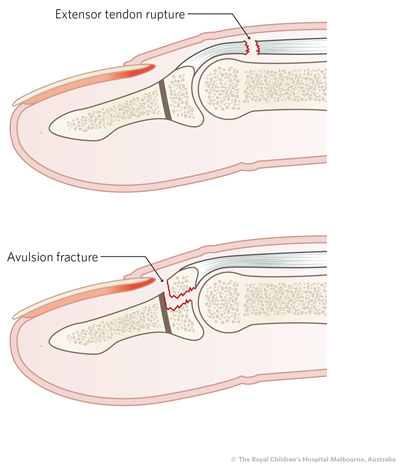
Management involves splinting the joint in neutral/ slight hyperextension (see at right); strictly avoid any flexion during the first 4-6 weeks, including during any splint changes.
Follow up is with Hand Surgery team.
|
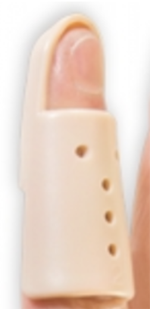
|
|

|
Seymour Fracture: Crush/ hyperflexion injury distal phalanx with associated nailbed injury (often seemingly mild), and injury to growth plate. The nail plate is often displaced superficial to the eponychium
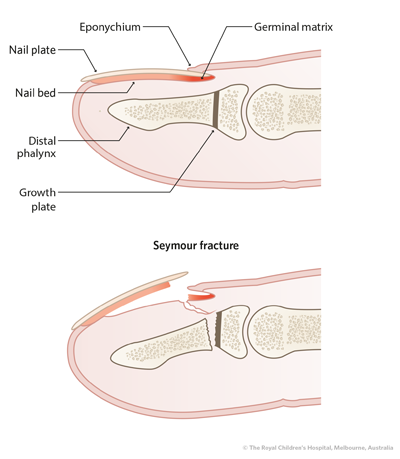
Management requires washout, debridement, reduction, nailbed repair and antibiotics, as this is an open fracture.
|
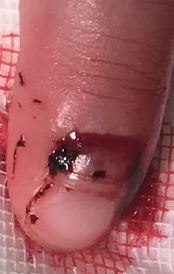
|
Middle or Proximal Phalanx Fractures
|
|
Shaft Fracture
Management: Reduction in ED if angulated or displaced.
Place in neutral hand splint. (Buddy taping may be ok for non-displaced fracture)
|
|
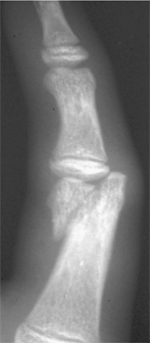
|
Condyle fracture (a.k.a. Head fracture)
One or both condyles may be affected - a unicondylar fracture is shown.
Management: these require early exact anatomical reduction by the Hand Surgery team to prevent joint deformity developing.
This usually involves placement of K-wires or Open Reduction with Internal Fixation
|
|

|
Phalangeal Neck Fracture
On examination there is usually evident dorsal displacement along with bruising swelling and tenderness
Management requires early expert anatomical reduction by the Hand Surgery team (ie within a few days). This is to prevent an extension deformity developing.
Place in neutral hand splint until surgical repair.
|
|
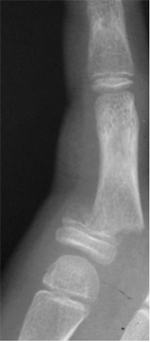
|
Salter Harris II Fracture at base of phalanx
On examination there is localised swelling bruising and tenderness. There may be significant deformity.
Management involves reduction in ED if angulated; neutral hand splint
(It can be difficult to isolate proximal fragment in P1 fractures to allow reduction: a biro in the webspace can help provide a fulcrum to correct angulation)
Follow up is with Hand Surgery team in clinic, particularly for any angulated or manipulated fractures.
|
|
|
Salter Harris III or IV Fractures
Management: Splint in a neutral position and arrange Hand Surgery follow-up.
May need operative management if joint surface involvement >30%
|
|
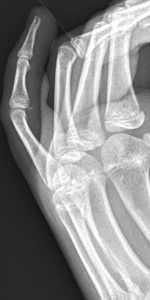
|
Volar Plate injury Hyperextension injury, often from ball sports or following a dislocated finger.
Examination reveals localised bruising or tenderness on volar aspect of joint, usually PIP. (Findings can be subtle).
On X-Ray there may or may not be an avulsion fragment , as shown here.
Management: Apply a dorsal splint to prevent hyperextension (see illustration under point 9 below).
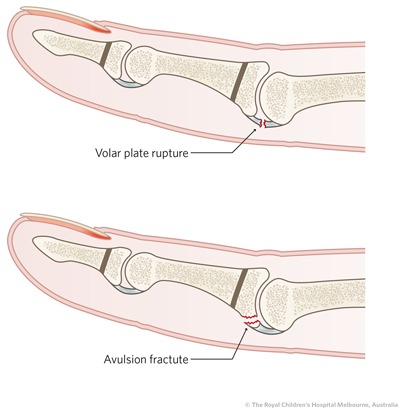
|
7. When is reduction (non-operative or operative) required?
This is listed in the above table.
8. Do I need to refer to hand surgery now?
- Open fractures including Seymour fractures.
- Associated vascular or neurological injuries.
- Condylar fractures and phalangeal neck fractures have much better outcomes with surgical treatment within a few days of injury.
- Severe rotational deformity (mild to moderate rotational deformity are suitable to be seen in an outpatient setting).
Other injuries can be followed up in clinic as below.
9. What is the usual ED management of these fractures?
Management of specific injuries is listed in the above table.
Most closed hand injuries (except volar plate injuries) can be protected in a neutral hand splint, with the wrist slightly extended, the metacarpo-phalangeal joints in 70-90 degrees of flexion and the interphalangeal joints in extension. This is sometimes called the ‘safe hand position’.
Neutral hand splint, which should be held in place with crepe bandage, with cotton placed between the fingers to protect the skin from maceration over the following week/s.
Some minor injuries are suitable for a simple buddy tape
.
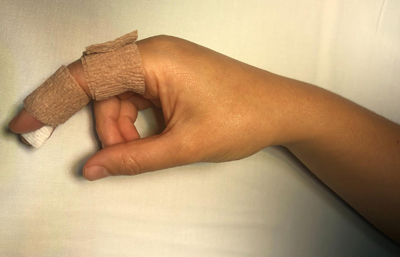
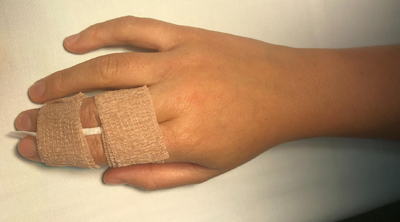
Buddy taping: cotton should be placed between the fingers before taping. Be aware that plaster tape (eg leukoplast) can cause nasty reactions in some children if placed directly against the skin.
Volar plate injuries should be splinted in a dorsal blocking splint (extension-limiting splint).
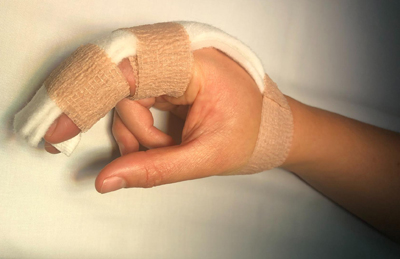
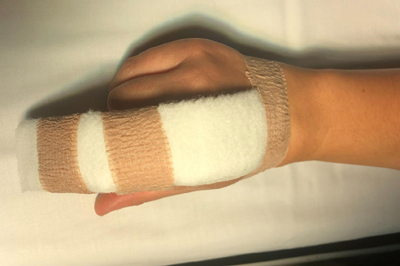
Dorsal blocking finger splint for index or middle finger: after buddy taping as in the images above, a splint has been fashioned out of fibreglass and taped in place. Aluminium with appropriate padding is an appropriate alternative.
All injuries should be elevated in a sling for approximately a week, regardless of whether surgical management is required.
10. What follow up is required?
Follow up for specific injuries is listed in the table above. Hand surgery clinic follow up should entail both surgical review and occupational therapy or physiotherapy review and advice.
11. What advice should I give to parents?
- Advice regarding the care of the splint or plaster applied.
- Elevation in a sling for the first week after injury (regardless of whether surgical management is planned) helps to reduce swelling and improve healing.
- Avoid any activities which risk a significant impact to the splint or the injured area, such as sports.
- Discussion of appropriate follow-up depending on the injury type as above.
- Note that regular follow up of certain injuries, including condylar fractures, mallet fingers and volar plate injuries is important in order to prevent poor hand function in the long-term. This will involve review and decision making by the surgical team, but also rehabilitation advice by the occupational therapy team.
What are the potential complications associated with these injuries?
Phalangeal fractures can be highly prone to displacement, making follow-up very important.
Inadequate management of Seymour fracture can result in Osteomyelitis, growth arrest and nail deformities.
Inadequately reduced rotational deformity of any digit can result in scissoring of fingers and significant functional impairment.
Missed or inadequately reduced condylar fractures will result in joint deformity, dysfunction and pain.
Volar Plate injuries, even if subtle, can result in chronic subluxation and/or persistent Swan-neck deformity.
References
Cornwall, “Paediatric Finger Fractures: Which Ones Turn Ugly” J. Pediatr Orthop 2012;32:S25-31
Smit, A. “Fractures in the Child’s Hand” Current Orthopaedics 2006; 20:461-66
Nellans, K. et al “Pediatric Hand Fractures” Hand Clin 2013; 29(4): 569-78
Information Specific to Royal Children’s Hospital: At RCH these injuries are managed by the Plastic Surgery Team. At some centres they may be handled by an orthopaedic team: this guideline uses the term ‘Hand Surgery’ to encompass either specialty.
Last updated December 2020